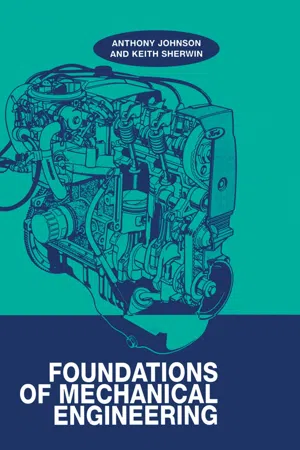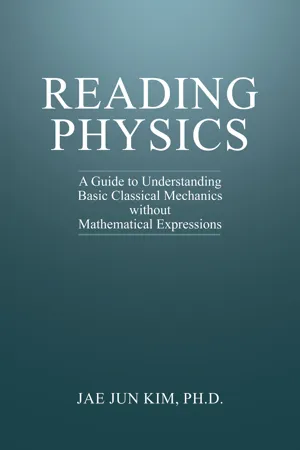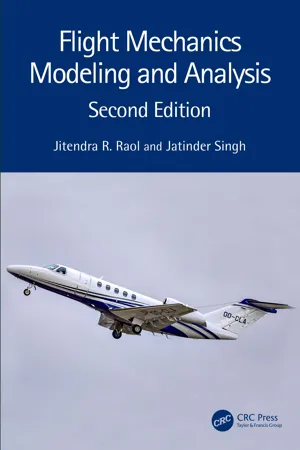Mathematics
Relative Motion
Relative motion refers to the measurement of the motion of one object with respect to another. In mathematics, it is often used to analyze the movement of objects in relation to a frame of reference. This concept is important for understanding the dynamics and kinematics of systems involving multiple moving parts.
Written by Perlego with AI-assistance
Related key terms
4 Key excerpts on "Relative Motion"
- eBook - ePub
- A. D. Johnson(Author)
- 2017(Publication Date)
- CRC Press(Publisher)
Motion of bodies 22.1 Aims
- To introduce the concepts of linear and angular motion.
- To explain the relationships between displacement, velocity and acceleration.
- To explain the relationship between absolute and relative velocities.
- To define the equations used to analyse linear and angular motion.
- To introduce an approach by which linear and angular motion problems can be analysed.
- To explain related topics such as ‘falling bodies’, ‘trajectories’ and vector methods.
2.2 Introduction to Motion
When traffic lights turn to green a car will move away with increasing velocity. The car will cover a distance in a particular direction and will possess a particular velocity at any instant. During this process the car possesses the three basic constituents of motion, namely: displacement, velocity and acceleration. It should be noted that since the car runs on wheels, these will also be in motion and therefore possess displacement, velocity and acceleration. However, the car moves in a linear direction, while the wheels move in an angular direction.2.2.1 Displacement
If a man walks 10 km, there is an indication of the distance between the start position and the final position, but there is no indication of the direction. The 10 km is merely the distance covered and, as such, is a scalar quantity, i.e. possessing magnitude only. Displacement, however, implies a change in position or movement over a distance and gives the position and direction from the start point. Thus displacement is a vector quantity possessing both magnitude and direction.Fig. 2.1 Displacement diagram.Figure 2.1 gives an example of a man who walks 3 km east then 4 km north. He has actually walked a distance of 7 km but has been displaced from his start point by only 5 km.2.2.2 Velocity
Velocity is the value of displacement measured over a period of time. It is the rate over which a distance/displacement is traversed. The magnitude of velocity is often expressed in convenient units such as kilometres per hour or miles per hour; however, these should be regarded as observation and comparison units. For analysis purposes velocity is better expressed in SI units of m/s. - eBook - ePub
Reading Physics
A Guide to Understanding Basic Classical Mechanics without Mathematical Expressions
- Jae J. Kim(Author)
- 2023(Publication Date)
- Universal Publishers(Publisher)
Remember: understanding the differences between vector and scalar is important. Likewise, it is also very important to understand what the orthogonality relationship is, especially when you are going to study a projectile motion, a motion in two- or higher dimensional space. If you do not understand what the relationship is about, you are going to have a hard time firmly grasping how we end up with various physical quantities in the projectile motions in higher dimensional space. For that reason, I highly encourage you to ensure that you understand what the orthogonality relationship is about, especially in the Cartesian coordinate system, before moving on to the topics in dynamics, including Newton’s laws of motion.Problems:Day 10 Motion in the vertical direction You hold a coin and then release it. What does the motion associated with the coin look like?Imagine you are driving a car going 80 miles per hour on a highway and a truck driver is driving his or her truck on the opposite side with the same magnitude of velocity. Think about the relative velocity of your car with respect to the truck and vice versa.For the example that is described in the lesson, imagine that someone else is moving with the same the velocity as that of the wind; calculate the velocity of your car with respect to that someone else.You are driving your car 40 miles per hour from south to north and the wind happens to blow from west to east at 30 miles per hour. Calculate the velocity of your car with respect to a person standing on the ground. Calculate the velocity of your car with respect to the wind. Think about the difference between the two cases.Find the two most common coordinate systems in physics. Define the two coordinate systems and think about the reason or reasons that it is easier to understand the orthogonality in Cartesian coordinates.You hold a coin and release it. What happens then? The increase in velocity is affected by the size of the gravitational acceleration. In essence, that is all that we need to know when studying a motion in the vertical direction.You hold an object and realize that it accelerates because of the Earth. That is what a motion in the vertical direction is about. - eBook - ePub
- Hiqmet Kamberaj(Author)
- 2021(Publication Date)
- De Gruyter(Publisher)
ˆ , move as the particle moves along the circular path.Figure 4.10 Illustration of the non-uniform circular motion.4.6 Relative Motion
We will also discuss the measurement of the displacement, velocity, and acceleration relative to observers in different frames of reference related to each other. For example, consider two observers in reference framesS 0and S, respectively, where S is moving relative toS 0with constant velocity v along the positive x-axis, as shown in Fig. 4.11 . Suppose the origin initially and the axes of both reference frames coincide. After a time t, the reference frame S is displaced to the right, along the positive x-axis by the vectorv t, as depicted from Fig. 4.11 . We denote with r the position of the particle P at time t measured by the observer in frame S, and withr 0its position measured by the observer in the frameS 0.Figure 4.11 The first observer is located at the fixed reference frameS 0and the second observer at the moving reference frame S with constant velocity v along the positive x-axis. The particle is located at point P - eBook - ePub
- Jitendra R. Raol, Jatinder Singh(Authors)
- 2023(Publication Date)
- CRC Press(Publisher)
3 ]. The chapter ends with a simplified explanation of the physics behind the working of gyroscope.2.2 Kinematics
The kinematics is concerned with the static aspects of mechanics wherein the inherent cause of the motion is not taken into account.2.2.1 Rectangular Cartesian Coordinates
Rectangular Cartesian coordinates are associated with orthogonal xyz axes that are right-handed by convention. Such coordinates are generally used to define position, velocity, and force vectors. For instance, position vector can be defined in terms of its components x, y, and z. Figure 2.1 shows the components of the position vectorR →. Assuming that the components ofR →vary with time, the position vectorR →can be expressed asFIGURE 2.1 Rectangular Cartesian coordinates.(2.1)R →= x( t )i ^+ y( t )j ^+ z( t )k ^wherei ^,j ^, andk ^are unit vectors. It is easy to obtain the velocity vector by differentiating (2.1) for position vector.(2.2)V →= u( t )i ^+ v( t )j ^+ w( t )k ^Further differentiation of the equation forV →shall provide the acceleration(2.3)a →=a x( t )i ^+a yj ^+a zk ^Here,u =,x ˙v =,y ˙w =; andz ˙,a x=x ¨,a y=y ¨a z=z ¨
Index pages curate the most relevant extracts from our library of academic textbooks. They’ve been created using an in-house natural language model (NLM), each adding context and meaning to key research topics.



